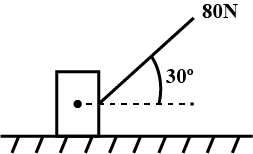
The coefficient of friction between the block and the surface is most nearly:

A. 5
B. 2
C. 0.87
D. 0.50
E. 0.13

Answer
556.8k+ views
Hint: This is a direct question. Firstly, we will compute the horizontal force acting on the block. This horizontal force is equal to the frictional force between the block and the surface. Using this value of the frictional force, we will find the value of the coefficient of friction by dividing the frictional force by the force acting on the block.
Formula used:
\[{{F}_{H}}=F\cos \theta \]
\[f=\mu F\]
Complete answer:
From the data, we have the data as follows.
The force applied on the block placed on the surface is,
F = 80 N
The angle made by the force with the horizontal is,
\[\theta =30{}^\circ \]
Firstly, we will compute the horizontal component of the force
The formula used is as follows:
\[{{F}_{H}}=F\cos \theta \]
Where \[{{F}_{H}}\]is the horizontal component of the force \[\cos \theta \]represents the horizontal angle and F is the force applied on the block.
Substitute the given values in the above equation.
\[\begin{align}
& {{F}_{H}}=80\cos 30{}^\circ \\
& \Rightarrow {{F}_{H}}=80\times \dfrac{\sqrt{3}}{2} \\
& \Rightarrow {{F}_{H}}=69.6\,N \\
\end{align}\]
This horizontal force equals the frictional force acting between the block and the surface.
So, we have the frictional force as follows.
\[\begin{align}
& f={{F}_{H}} \\
& \Rightarrow f=69.6\,N \\
\end{align}\]
Now, we will compute the coefficient of friction between the block and the surface.
The formula used is as follows:
\[f=\mu F\]
Where f is the frictional force, \[\mu \]is the coefficient of friction and F is the force applied on the block.
Substitute the obtained and the given values in the above equation. So, we get,
\[\begin{align}
& 69.6=\mu \times 80 \\
& \Rightarrow \mu =\dfrac{69.6}{80} \\
& \Rightarrow \mu =0.87 \\
\end{align}\]
As the value of the coefficient of friction between the block and the surface is most nearly equals 0.87.
So, the correct answer is “Option C”.
Note:
The units of the parameters should be taken care of. As, in this case, the frictional force, the force applied on the block and the horizontal component of the force should have the same unit. As the force makes a horizontal angle with the surface, thus, the cos function is used, if the force makes a vertical angle with the surface, then, the sin function must be used.
Formula used:
\[{{F}_{H}}=F\cos \theta \]
\[f=\mu F\]
Complete answer:
From the data, we have the data as follows.
The force applied on the block placed on the surface is,
F = 80 N
The angle made by the force with the horizontal is,
\[\theta =30{}^\circ \]
Firstly, we will compute the horizontal component of the force
The formula used is as follows:
\[{{F}_{H}}=F\cos \theta \]
Where \[{{F}_{H}}\]is the horizontal component of the force \[\cos \theta \]represents the horizontal angle and F is the force applied on the block.
Substitute the given values in the above equation.
\[\begin{align}
& {{F}_{H}}=80\cos 30{}^\circ \\
& \Rightarrow {{F}_{H}}=80\times \dfrac{\sqrt{3}}{2} \\
& \Rightarrow {{F}_{H}}=69.6\,N \\
\end{align}\]
This horizontal force equals the frictional force acting between the block and the surface.
So, we have the frictional force as follows.
\[\begin{align}
& f={{F}_{H}} \\
& \Rightarrow f=69.6\,N \\
\end{align}\]
Now, we will compute the coefficient of friction between the block and the surface.
The formula used is as follows:
\[f=\mu F\]
Where f is the frictional force, \[\mu \]is the coefficient of friction and F is the force applied on the block.
Substitute the obtained and the given values in the above equation. So, we get,
\[\begin{align}
& 69.6=\mu \times 80 \\
& \Rightarrow \mu =\dfrac{69.6}{80} \\
& \Rightarrow \mu =0.87 \\
\end{align}\]
As the value of the coefficient of friction between the block and the surface is most nearly equals 0.87.
So, the correct answer is “Option C”.
Note:
The units of the parameters should be taken care of. As, in this case, the frictional force, the force applied on the block and the horizontal component of the force should have the same unit. As the force makes a horizontal angle with the surface, thus, the cos function is used, if the force makes a vertical angle with the surface, then, the sin function must be used.
Recently Updated Pages
Why are manures considered better than fertilizers class 11 biology CBSE

Find the coordinates of the midpoint of the line segment class 11 maths CBSE

Distinguish between static friction limiting friction class 11 physics CBSE

The Chairman of the constituent Assembly was A Jawaharlal class 11 social science CBSE

The first National Commission on Labour NCL submitted class 11 social science CBSE

Number of all subshell of n + l 7 is A 4 B 5 C 6 D class 11 chemistry CBSE

Trending doubts
What is meant by exothermic and endothermic reactions class 11 chemistry CBSE

10 examples of friction in our daily life

One Metric ton is equal to kg A 10000 B 1000 C 100 class 11 physics CBSE

1 Quintal is equal to a 110 kg b 10 kg c 100kg d 1000 class 11 physics CBSE

Difference Between Prokaryotic Cells and Eukaryotic Cells

What are Quantum numbers Explain the quantum number class 11 chemistry CBSE




